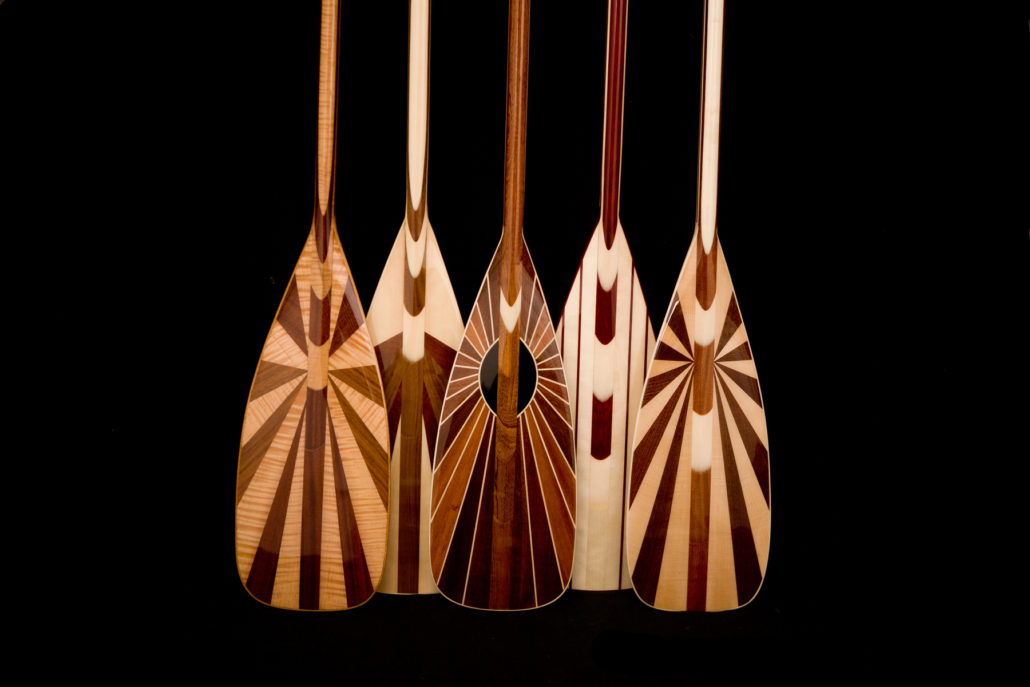As paddlesports enthusiasts gain skill and experience, many choose to upgrade to higher performance equipment; the paddle is no exception. The paddle is arguably the mostcritical piece of gear you can buy to help improve your skills and paddling stroke technique.
Traditionally, all paddles were made of wood. Yet, with the advent of new materials and technology, the market has become saturated with paddles at every performance level, from entry-level to high end providing a wide range of choice for all sports. Despite modern innovations and newer materials available at ever-lower prices, many paddlers are choosing to stick with or return to wood. At PADDLEexpo, wooden paddles were on display in every price range for almost any paddling discipline, from Freefall’s custom-made Re-Paddles to Palm’s Delta, a molded‚ laminated ponderosa pine-walnut-ash blade.
What is it about a wooden paddle that has stood the test of time? Some argue that the biggest advantage of wood lies in its visual appeal; others tout the feel of a wooden paddle, the options different woods afford, or the commitment to quality.
While the biggest advantage of composite construction is likely utility–the combination of high strength and low weight–where they are lacking, some argue, is in the beauty, warmth, and “soul” that wood can provide. Obviously, composites sell, and sell well. Those who buy them clearly find the trade-offs worth it. Yet for those who want something more, “an all-wood paddle is attractive, responsive and warm to the touch. It remains by far the most popular material for canoe paddles,” says Bending Branches.
“Most paddlers who want wooden paddles are looking for that special organic connection to the river that they will never get from plastics or composites,” explains Freefall Paddles owner and founder Peet Reid. While Reid’s company also makes a carbon composite blade, they specialize in handmade wooden canoe paddles. Their Re-Paddle uses re-purposed wood, adding the benefit of being eco-friendly. “We have turned desks and doors into paddles, and shipped them all over the world, where they are appreciated not only as paddles, but as works of art,” states Reid.
Design is equally as important as function. Freefall crafts paddles uniquely suited to different regions. “Most of our blades sold to North America are long blades, while those sold to Europe are short, due mostly to the shallow waters we paddle in Europe. But,” continues Reid, “all paddlers want the same new innovative styles and designs. For us, design and materials are critical. We hand make all of our wood paddles, as usually we are making for a paddler who wants a unique and distinctive paddle made just for them.” The art of the hand-made or custom-made paddle remains a sort of status symbol, or a way of showing appreciation for craftsmanship and the history of paddle sports.
Most Greenland-style paddles, a sea kayak blade with a long narrow shape, are traditionally manufactured in wood. East Pole paddles offers consumers the choice of western red cedar or black alder, red cedar being lighter weight, black alder more durable. Other common wood choices are Sitka spruce, Douglas fir, or varieties of ash or cherry.
“Wood is nature’s own composite,” writes Grey Owl Paddles on their website. “As a naturally forming polymer, wood is comprised of long-chain, cross-linking cellulose molecules, bound together with lignum. This miraculous combination gives wood its unique properties of strength, stiffness, resilience, buoyancy, and durability.”
The advantages are clear. Wood is touted for its flexibility, as paddles with a flexible shaft are better for your shoulders and other joints, therefore extending the amount of time you can spend on the water. There is no beating wood’s natural buoyancy- a wood paddle will always surface if dropped, helpful if waves toss you around. Wood paddles are typically robust and long-lasting. If damaged, they can be easily re-finished to look as good as new, and they offer the near-limitless capacity for customization. Those who choose a wooden paddle have made an investment into their paddling career, and found a paddling companion that will likely last a lifetime.
“What makes a great paddle is a combination of many things,” says Grey Owl. “A grip that fills the palm just so; a shaft that is smooth, oval, and doesn’t twist in the hand; a blade that knifes into the water without a ‘plop’; a lively action that pulls without a flutter or vibration…” It is what we are all looking for, a way to connect to the water.
By: Anna Bruno, Kayak Session, Paddle World and Sup World Mag editor.


